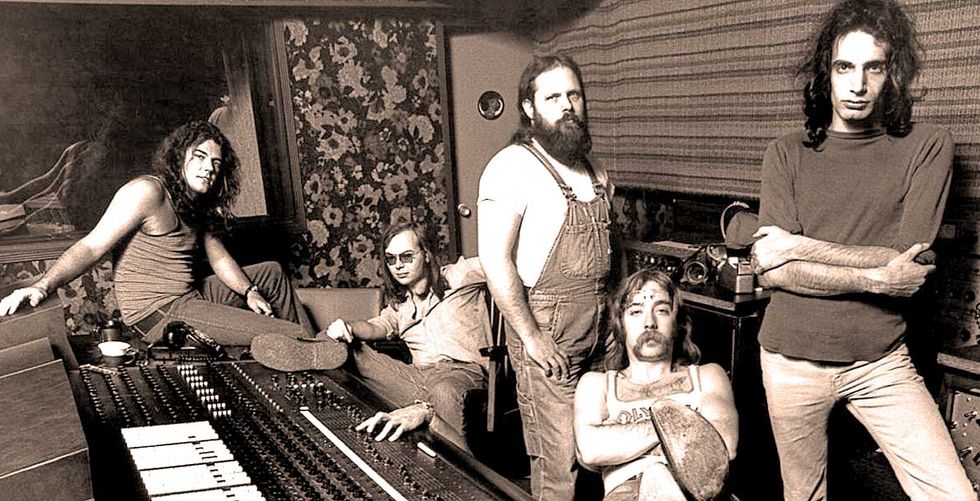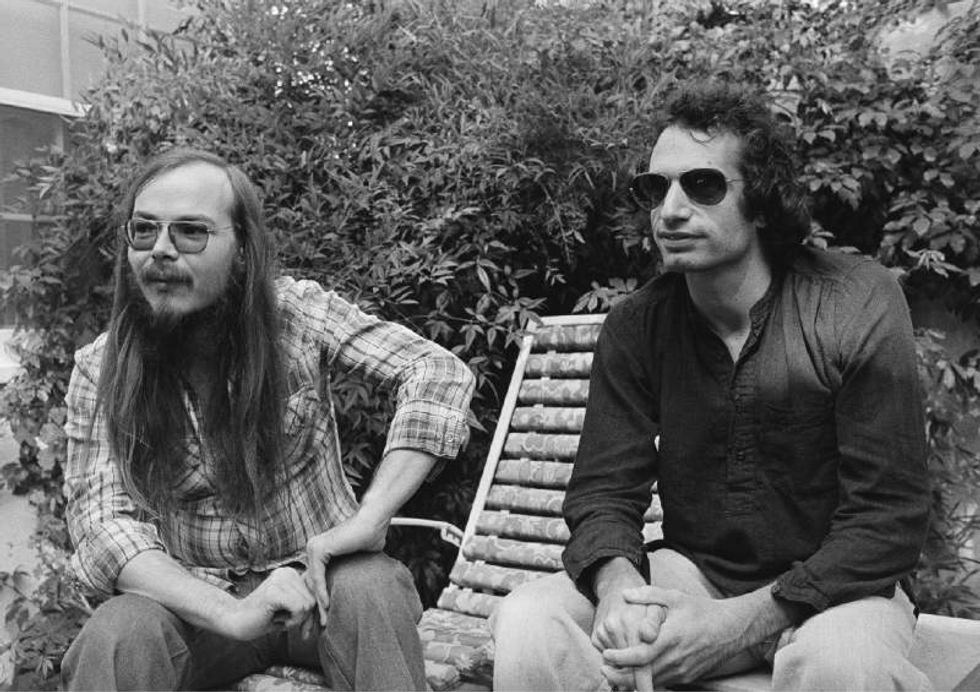In 1999, Steely Dan's renowned jazz-rock release Aja (1977) was featured on an episode of Classic Albums, a British documentary series that delves into the creative process behind some of the most iconic albums of all time, including the likes of Fleetwood Mac's Rumours and the Beach Boys' Pet Sounds. After retiring from playing live shows, co-leaders Donald Fagen and Walter Becker ventured out to California to record their next project with contributions from some of the finest musical talent Los Angeles had to offer.
A masterful blend of rock n' roll attitude and jazz harmony peppered with pop sensibilities, Aja quickly became Steely Dan's best-selling record, the first release of the band's to reach platinum status, and the winner of the Grammy Award for Best Engineered Album, Non-Classical in 1978. The neurotic recording processes, the extensive repertoire of talent used, and the combined genius of Donald Fagen and Walter Becker leaves Aja in a class of its own that has never come close to being matched even forty years later.
Aja is the quintessence of the Steely Dan sound: yacht-smooth and polished, sardonic and dry, beatnik and bohemian. Meandering jazzy chord changes are swaddled in radio-friendly rock tune arrangements and blanketed in rich vocal harmonies and complex horn sections.
The first single off the record, "Peg," features a rolling bass line over a jazzed-up blues progression and a hook drenched in vocal harmony; "Home At Last" is a groovy, swung, yet nostalgic allusion to the myth of Greek hero Ulysses as a homage to their home of New York City. The eight-minute title track features shimmering piano embellishments and a blistering saxophone solo from none other than jazz legend Wayne Shorter.
Despite writing the majority of this record in the City of Angels, Fagen and Becker weren't quite done writing about New York characters yet; opening track "Black Cow" describes a woman at one of the many diner counters that decorated the city in the 70s, and "Deacon Blues" sings a gospel of a beatnik who dreams of becoming an alcoholic jazz saxophonist. Where else would you find such characters except in New York?
The album is so renowned that in 2010 the Library of Congress selected Aja for inclusion in the United States National Recording Registry based on its cultural, artistic, and historical significance (finally, some part of Congress that isn't completely out of touch).

There are many reasons why a record like Aja could never be made again, the first simply being the logistics of the recording process. Largely recorded in Los Angeles over the span of six months, the duo were in the studio nearly every day with their ever-changing lineup of session players.
In total, there are a whopping 36 studio musicians credited in the recording of Aja, an all-star lineup that includes the legendary jazz saxophonist Wayne Shorter, the original "hit-maker" drummer Bernard Purdie, vocal powerhouse Michael McDonald, fusion guitar god Larry Carlton, and smooth-as-silk veteran bassist Chuck Rainey.
This wide array of musicians allowed for entirely different bands to rotate playing on each track, resulting in sort of highly complex musical chairs that could never be achieved today. This same process was repeated with Steely Dan's seventh studio album Gaucho (1980), which credits a staggering 42 studio musicians and took over a year to perfect, vastly exceeding the budget allotted by their record label. With the amount of micromanaging labels do these days, Fagen and Becker's extravagant (but 100% worthwhile) spending would never be allowed.

No matter how anal modern artists may be about their recording processes, they will absolutely never hold a candle to the perfectionism of Fagen and Becker. The duo would never "just settle" on a take if it didn't deliver the feel they desired.
They would have countless musicians come into the studio and obsessively record take after take, all the while knowing that none of them would be used and would consequently be trashed. Still, they would often keep the session players in the studio day in and day out, with sporadic meals being their only opportunities for breaks.
It's fortunate that those whom the duo employed shared their goal for perfection, including audio engineering pioneer Roger "The Immortal" Nichols, who had previously worked on the band's previous four records and would go on to break ground with his work on the band's final album before going on hiatus, Gaucho (1980). Nichols was born a tech geek and a devout audiophile; he left his job as a nuclear operator to infiltrate the record making industry solely because the quality of the sound wasn't up to his standard.
When Nichols found himself a job as an audio engineer at ABC Dunhill in 1971, he met songwriting team Fagen and Becker along with executive producer Gary Katz, who would become a long-time Steely Dan collaborator. Nichols and the duo couldn't have had more different backgrounds; the bold engineer grew up recording high school friends' bands in his garage in California, while the city-slicked New Yorkers were isolationist self-proclaimed "jazz snobs" who liked science fiction novels and sarcastic humor.
More importantly, they both loved pristine audio quality and had the perfectionist bug. Fagen and Becker's neurotic recording process would've caused any other engineer but Nichols to throw in the towel, and there is yet to be someone who is just as obsessive about sonic perfection as he. For this, Steely Dan has earned their title of the biggest divas in jazz-rock.

In the long history of songwriting duos, it's rare to hear of a partnership that didn't have some sort of rivalry: Lennon-McCartney, the Gallagher brothers, even Simon and Garfunkel. However temperate the relationship may have been, no duo could hold a candle to the synchronization of Fagen and Becker. There could not be more clarity of the vision the two share, as harmonious as Siamese twins separated at birth.
Watching them converse in the studio while being interviewed for Classic Albums is absolutely astounding; they even go to the lengths of finishing each other's sentences as if it's second nature. If there ever is another songwriting team as talented and as in-sync as them, the Billboard charts better prepare to be adorned with a countless number of their hits.
When Fagen and Becker weren't holed up in the studio, they would lock themselves away in their houses in Malibu, feeling alienated by the laid-back beachcomber culture of Los Angeles. They called the city "Planet Stupid", and they themselves were practically a counterculture to the counterculture; the hippie vibes of the West Coast couldn't have differed more from the hip coolness of New York.
However, they had nothing but respect for the Los Angeles musicians that graced the tracks of Aja, citing their precision and knowledge of recording music as legs up over the harder-hitting attitudinal New York cats. This combination of East and West Coast styles gave the music an extremely distinctive style, radio-friendly but still incredibly hip, warm and groovy yet cool and sophisticated.

It's no secret that Fagen and Becker are largely influenced by the writings that emerged in the Beat generation of the 50s and 60s; even the name Steely Dan was derived from William S. Burroughs' vignette novel The Naked Lunch. A generation characterized by glamorized defeat, the beatniks would often venture from the East Coast to the West, seeking out ways to revel in their divine loserdom and do some soul-searching.
Maybe that's why Fagen and Becker could make lemonade out of the Los Angeles lemons they were handed. In the true beatnik Kerouacian fashion, they ventured out west to create something new and beautiful.
Maybe one day there will be another movement that would inspire some rocked-out jazz musicians from New York to travel across the country, work tirelessly with neurotic ex-nuclear physicist audio engineers and musical legends with careers spanning across four decades, and create timeless music that caters as much to the mind as it does to the heart and still does forty years later.
Then again, probably not.
♫ ♪ ♬
Walter Carl Becker
February 20th, 1950—September 3rd, 2017
















